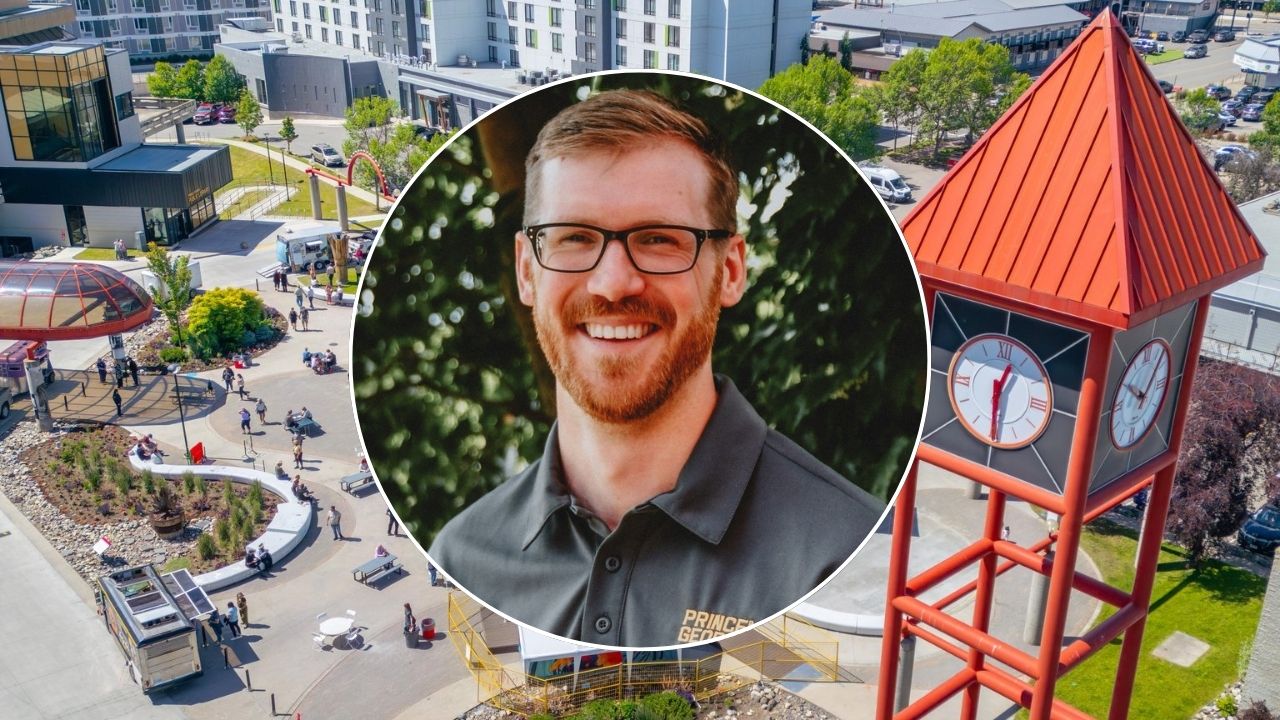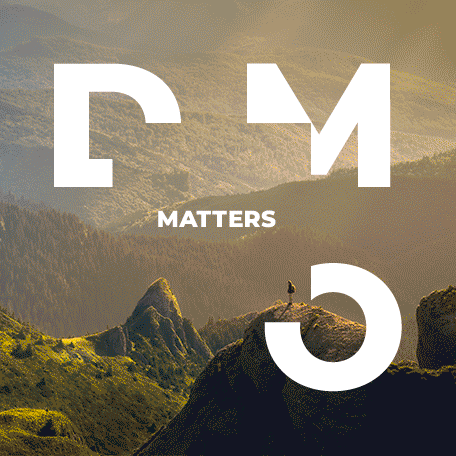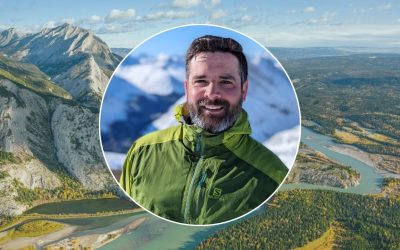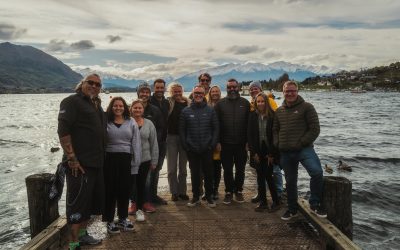“The thing that resonates with them (visitors) the most is talking to the local potter who’s operating out of this shipping container market. It’s those kind of real connections with real people.” – Colin Carson
What if your visit to a northern Canadian city could help transform an entire community’s sense of pride? In Prince George, British Columbia, that’s exactly what’s happening.
As this industrial hub of 80,000 people faces economic transitions from traditional forestry, Tourism Prince George is pioneering innovative ways to make tourism work for locals. With over 1,600 lakes, rivers, and creeks within 100 kilometers and access to the world’s only inland temperate rainforest, Prince George is leveraging its natural assets while creating new urban experiences that serve both visitors and residents.
The organization’s latest project exemplifies this approach: a year-round artificial ice rink surrounded by five converted shipping containers that rotate local vendors weekly. Located steps from downtown hotels and shops, the new Nanguz ‘An (Fox Den) container market provides low-barrier entrepreneurship opportunities for locals while offering visitors authentic, ever-changing experiences in the heart of northern BC.
But the impact goes deeper than economics. As Colin Carson explains in this episode, Prince George faces a unique challenge – residents who are incredibly welcoming to visitors often speak negatively about their own community. Tourism is helping shift this narrative by creating spaces and experiences that build local pride while showcasing what makes Prince George special.
From the ancient cedar forests protected by the Lheidli T’enneh First Nation to the innovative downtown renewable energy system that heats a dozen buildings with sawmill waste, Prince George demonstrates how tourism can amplify existing community strengths while creating new ones.
You’ll also learn:
- How Prince George’s shipping container market is creating entrepreneurship opportunities while building community pride
- Why this northern BC city sees tourism as crucial economic diversification from traditional resource industries
- How visitor education helps protect northern BC’s vast wilderness and indigenous heritage
- How the world’s only inland temperate rainforest offers unique four-season experiences
- Why authentic local connections in small communities create the most memorable travel experiences
Subscribe to Travel Beyond through Apple Podcasts, Spotify, or your favourite podcast player.
Show notes
Ancient Forest Provincial Park – British Columbia’s newest provincial park, featuring the world’s only inland temperate rainforest, with universally accessible boardwalks through ancient cedar trees.
Lheidli T’enneh First Nation – The local First Nation working with Tourism Prince George to develop cultural tourism experiences and protect important heritage sites.
Tourism Prince George – The destination management organization working to position Prince George as both a northern gateway and destination in its own right.
Prince George Container Market & Ice Rink — An innovative year-round attraction featuring rotating local vendors in converted shipping containers surrounding an artificial ice rink.
Downtown Prince George Renewable Energy System — A district heating system that uses sawmill wood waste to heat over a dozen downtown buildings, including hotels and civic facilities.
Prince George photo credit: Tyler Macsemniuk
Colin Carson photo credit: Tourism Prince George
Episode transcript
Colin Carson: The thing that resonates with them the most is talking to the local potter in Prince George who’s operating out of this shipping container market. And that’s going to be the most impactful thing that they can take home. It’s not the grand experience in these things; it’s those real connections with real people. So if we can have those interactions, I think that’s the best thing we could do to really positively impact the visitor here in Prince George.
Peter McCully: Welcome to Travel Beyond. I’m Peter McCully for Destination Think. On this episode, we look at travel’s role in making a better world, and we highlight leading destinations and change makers. Our guests are taking local action that the world can learn from. They’re helping to regenerate ecosystems, communities, and economies, and they’re sometimes making positive change happen from the bottom up.
Many of the voices we’ve highlighted are part of the Destination Think Collective, a peer group of more than 20 ambitious, forward-thinking destinations working toward a better future for travel and the planet. As you heard at the beginning of the podcast, our topic is how visitors to Prince George are making real connections with real people at a shipping container market.
Tourism Prince George is pioneering innovative ways to make tourism work for locals. The organization’s latest project exemplifies this approach: a year-round artificial ice rink surrounded by five converted shipping containers that rotate local vendors weekly. Located steps from downtown hotels and shops, this container market provides low-barrier entrepreneurship opportunities for locals while offering visitors ever-changing outings—not to mention the classic Canadian experience of skating outdoors, even in the summer, in the heart of Northern British Columbia.
Prince George faces a unique challenge. Residents who are incredibly welcoming to visitors sometimes speak negatively about their own community. Tourism is helping shift this narrative by creating spaces and experiences that build local pride while showcasing what makes the city special, and there’s plenty to be proud of here. Prince George is near a rare inland temperate rainforest, which is stewarded by the Lheidli T’enneh First Nation.
The city is also home to an innovative downtown renewable energy system that heats a dozen buildings using sawmill waste. And now, with the rink and the container market, Tourism Prince George is supporting two new projects that will amplify the community’s strengths while benefiting visitors and residents alike.
David Archer, editorial manager at Destination Think, spoke with Colin Carson of Tourism Prince George about how authentic local connections in small communities create the most memorable travel experiences.
Colin Carson: My name’s Colin Carson. I’m the Chief Executive Officer here at Tourism Prince George, the destination management organization for the Prince George area.
David Archer: How long have you been working with Tourism Prince George?
Colin Carson: I’ve been with Tourism Prince George for several years. A funny story, as it happens in these types of situations where I find a lot of people end up in the tourism industry by chance, or they started in that industry as a young worker and never left. But I joined Tourism Prince George covering a maternity leave, and they just couldn’t get rid of me after that. So it’s been probably the longest maternity leave coverage on record at this point. But I’m just thrilled to be part of a team here.
David Archer: For our listeners that maybe have not been to BC before, what would you like them to know about Prince George? Can you introduce the city a little bit?
Colin Carson: As you mentioned briefly in the introduction, Prince George is a city of about 80,000 people, and we’re really that service centre for all of Northern BC. That’s often what we’re viewed as, and it does provide some significant advantages for attracting visitors as that service centre.
We have some of the amenities you might not normally see in a community our size because we’re servicing a population of about 300,000 people that live throughout Northern BC and travel to Prince George for a variety of services. So that’s really the basis of our community—typically a big industrial community.
Lots of forestry-related work, lots of oil and gas mining-related work—a real blue-collar type of community that is charming and extremely welcoming in its own unique way. And that’s the number one thing I hear from visitors when they talk about it.
When you are walking around the community on the trails, you interact with locals and visitors, and it’s just the most welcoming and friendly people you could ever imagine. We are the gateway for the North, and we are that base camp to these northern adventures. And that’s something we’re really proud of.
We love to see these people on their long-haul trips, going all the way up to Alaska or doing the Great Northern Circle route within BC. We’re trying to find some unique and creative ways to get them to stay a little bit longer in Prince George while still experiencing the rest of the beauty that our region has to offer.
David Archer: It’s great to hear about the warm welcome that people receive. Can you tell me a little bit about some of the local points of pride? What are people excited about living in Prince George, whether it’s recreational or otherwise?
Colin Carson: It’s funny from the DMO perspective—one of the things that we often talk about is for the regional traveller that uses Prince George as a service centre, we’re the big city, and that’s what we promote: the great events that we have to offer and the great, really underrated culinary scene here in Prince George and these big city amenities that we offer.
And then to the international visitor, they come to Prince George because we’re in the middle of nowhere, and we’re this mecca for recreation and this area with so much nature surrounding us that we’re not the big city at all. So it’s really this balancing act in our promotional materials where we’re playing kind of both sides of that coin.
I think what’s really great is we can be anything to anyone, depending on what they’re looking for. I think that’s one of those great things about Prince George. And the other piece, I think that’s really growing here—and we’re really fortunate for the relationship with the local First Nation here.
The Lheidli T’enneh First Nation, their interest in developing tourism-related experiences and really viewing that as a way to protect their culture and be able to tell their story has been a really exciting trend that we’ve seen and a really positive step towards reconciliation for our organization.
David Archer: I was going to ask about the First Nation, the Lheidli T’enneh. I believe I’ve been to the Ancient Forest—is that connected to the First Nation as well?
Colin Carson: Yes, absolutely.
David Archer: Is that one of those experiences?
Colin Carson: Yes. Chun T’oh Whudujut, the Ancient Forest Provincial Park. I believe it’s still British Columbia’s newest Provincial Park. Part of the only inland temperate rainforest in the world. And the Lheidli T’enneh First Nation has played a huge role in conserving that. When the park was developed, it was set to be logged. Fortunately, a group of community members, including the Lheidli T’enneh and a few others from the university and other local groups, got together and really protected that area from logging. Now it’s this beautiful park with a universally accessible boardwalk and some great infrastructure that’s currently being developed there that’ll really turn that into an amazing experience for visitors or locals to go check it out and learn a lot about some really unique areas around the north-central area of British Columbia.
David Archer: It really is a special place in there. It actually reminds me a lot of Haida Gwaii.
Colin Carson: That’s what we often get is, “Oh, it feels like you’re in a coastal rainforest when you’re in there.” And it’s 800 kilometers from the nearest ocean when that’s happening. So really cool. The other thing that’s so cool about that is as an inland temperate rainforest and where they’re situated, typically you’d see that it’s a rainforest—they get all their moisture comes from the rain. The majority of the moisture in that area comes from snow, which is really unique as well from a geographic standpoint. Really cool to be able to talk about that. And in the wintertime, gorgeous, unbelievable snowshoeing amongst those monster cedar trees as well.
David Archer: So it sounds like this ancient forest project is somewhat of a stewardship project as well. Are there other places around the community where those sorts of things are popping up that might affect the travel experience?
Colin Carson: A couple of the other projects that we’re seeing that are really doing a great job of storytelling of either the Lheidli T’enneh or just the history of Prince George—one of them being the Exploration Place, the local museum here. It’s actually situated in Lheidli T’enneh Memorial Park, but they’re the record keeper for the Lheidli T’enneh Nation and do a really good job of educating visitors and locals about all sorts of different things about not only the Lheidli T’enneh, but other surrounding nations near Prince George.
So definitely recommended. Stop there if you want to learn more about local Indigenous culture here in Prince George.
David Archer: I did notice as well—we owe Mr. PG a happy birthday. Can you tell me about Mr. PG?
Colin Carson: Mr. PG is one of those things where, unless you’re from Prince George, you probably don’t fully understand the significance of Mr. PG. He is a 27-foot-tall mascot, an ode to the forest industry that was first developed in 1960. He’s actually made of metal now, and his body is a septic tank, which is pretty funny, but he still sits right at the junction of the two major highways in Prince George, welcoming visitors or people commuting every day.
Kind of the busiest intersection within Northern BC, but it’s shifted from this roadside attraction—and the community gets really excited about that—but to this really important piece of Prince George pride and culture where people are so passionate about him. I speak about Mr. PG as if it’s a real person, but people are so passionate about him and the statue and maintaining it that it probably veers a little bit over the line on occasion because people are like, “We can’t move him.” Reality is, he is a mascot for the community that promotes the quirky uniqueness of some of the culture and history in Prince George.
David Archer: That’s so fun. People get attached to icons like that over time, and I guess especially over many years.
Colin Carson: It’s funny. We operate the Visitor Centre here as well in Prince George, and we have a small gift shop. Part of our gift shop strategy is we’ll get local made and crafted things and whatnot. And no matter what we sell in the gift shop, if we have something with Mr. PG on it, that’s what sells first and fastest. People just love having that aspect.
David Archer: What impact would you like Prince George to have on visitors overall? Let’s say they’re coming in internationally, maybe not familiar with Western Canada. What impact would you like Prince George to leave on them?
Colin Carson: I think it goes back to that culture piece of stewardship and conservation. But I think we play a real unique role because those international travellers, when they’re stopping in Prince George, it’s part of a longer trip 95% of the time.
For us, knowing we’re usually one of the first stops on that trip, we can play a really important role in ensuring they are protecting the environment and nature and Indigenous history throughout their travels. And I think that’s something we really take to heart at Tourism Prince George, interacting with visitors, whether that’s through digital channels or in person at the visitor centre.
We want to make sure we’re educating them appropriately so for the rest of their trip—their time in Northern BC or in British Columbia or in Canada—they’re doing things properly, being stewards of the lands here in Northern BC.
David Archer: What are some of the ways that you’re sharing that information?
Colin Carson: Truthfully, the best way is we have a really great team of frontline workers that work at the Visitor Information Centre that are extremely passionate about this and really hold these values as individuals as well. So for them, it’s really just sharing their passion about these types of activities more than anything else.
We’ve got some really good, great relationships with local partners and stakeholders talking about ways to fish appropriately and making sure we have the proper fishing licences if we’re going to do that—things like following the guidelines set in the camper’s code and the leave no trace.
And especially as we’re seeing things progress with natural disasters in the Prince George area—a lot of forest fires over recent years—that’s obviously a big piece of this as well, making sure the visitors are properly educated on campfire appropriate uses and if they’re eligible to have them or not.
David Archer: That’s such an important piece, the safety aspect. Let’s talk a little bit about how tourism impacts locals. We said off the top we’re going to talk a bit about how travel makes Prince George a better place, and I suppose maybe that implies that some things need to change. But before we talk about how travel can help, can you describe maybe some of the challenges that locals are facing?
Colin Carson: I think one of the things that I mentioned about Prince George right off the hop was we’re typically viewed as a very industrial community and have historically relied on the forest industry. Over recent years, we’ve seen a number of mill closures—sawmill closures—in the Prince George area that have had a significant impact on jobs in the area.
That’s probably the biggest challenge that our community is seeing currently. I think there’s this unique and really cool opportunity for tourism to be viewed as a solution to that on an economic development level, where it is a great tool to promote well-being and it’s a great idea to promote travel.
But we also have this opportunity to be an economic driver and bring back some of that industry in a different sense, but really bring that back to the community and hopefully help solve a solution there.
David Archer: Is this kind of a new way of thinking in Prince George? Would you say, like among residents, if you could take the temperature, are people used to thinking this way about tourism?
Colin Carson: No, definitely not. And truthfully, it’s something that we are still actively working on as well. If you go out and talk to local residents here, they probably still are viewing these heavier types of industry as the solution.
I think that’s something that we’re working very closely with our partners on, trying to share these success stories of these tourism businesses—opportunities that exist in this non-traditional industry in our region. So I think there’s still a lot of that education happening, and you still would probably talk to a lot of local residents and they’re just hoping that things change and the sawmills open back up and that will fix these problems when it’s seeming like that’s likely not going to be the solution.
David Archer: It’s a transitional era for the city, maybe. What do you think tourism makes possible in Prince George that otherwise wouldn’t be? If you think beyond jobs and economics…
Colin Carson: Probably it’s the pride of place that’s the biggest thing—there’s this opportunity for tourism that creates these amenities and these products and these opportunities for people to be extremely proud of their community.
I think that’s something that we really struggle with as a city. We often talk about it—it’s hilarious. And I mentioned earlier, when you’re walking the trails of Prince George and you bump into residents, they’re the friendliest, most welcoming people. At the same time, those people are extremely tough on Prince George and often speak down about the community as a whole.
Then it’s this opportunity where tourism can actually play this pride-of-place piece in helping residents be more proud of what Prince George has to offer and see the value that is there. So I think it’s this really kind of unique opportunity and kind of conversation that we’re having internally: How can we be this welcoming community that we are at the same time we know that our local residents don’t speak highly of the community itself? It’s this kind of weird education in trying to create these local ambassadors who already have that welcoming aspect of them, but it’s this other piece to make sure they are these welcoming and great local ambassadors.
David Archer: That’s interesting. So building that pride of place creates ambassadors. What are some of the ways you think those ambassadors form? What changes someone’s mind to becoming like super proud of where they live?
Colin Carson: I think one of the things that we do is we try to get out to all these local community events as much as we can, with booths, with tables set up and providing information.
I think that’s a good way. We know that those events—also visitors do attend those—so we want to be interacting with visitors. But that other piece of attending those is so we can interact with the local Prince George residents. And I think that shift is about showing them all the things we have to offer.
Because I think the biggest problem is that the local residents live in their silo and they don’t tend to explore outside of that. So they don’t know that we have these great things to offer. And that’s probably the missing piece a lot of the time with creating these local ambassadors.
So for us, trying to get in front of them in any of those ways, in those types of events, in those settings, I think is number one. And then, I think we’re going to talk a little bit later about some of the work that we’re doing—some new projects. And I think that’s going to be the second piece: the shipping container market.
Really excited to be able to share that and have locals be the ones that are there and interacting with that, creating that environment for them to find an awesome experience within their hometown.
David Archer: You’ve just left me a great segue to talk about the ice rink and the container market that are happening in Prince George. Tell me about that whole experience and how that’s being developed.
Colin Carson: Yes, really a cool story. It was a Tourism Prince George staff member’s pipe dream of “Hey, we should do this.” It was a proposal sent to me. “Okay, this is cool. Let me pitch it to our board of directors and see what they say,” and went to the board—”Yes, let’s do it. That sounds great.” And then it was “How are we going to build this and where’s the funding going to come from?” Then it was really about looking at funding sources and doing some really great work and fortunately finding some really great partners and supporters that were able to fund this project that’s been under construction.
So what the final product is going to look like here is it’s going to be five sea-can shipping containers modified into retail spaces that’ll provide opportunities for local vendors not quite ready for retail spaces, but able to dip their toes into that entrepreneurship and have an opportunity at a really low barrier to sell their goods or services in these settings.
Those containers surround this artificial ice rink. It’s this year-round plastic-based ice rink, which is a really cool product. And it’s not like skating on real ice, but it’s still this really cool, authentic Canadian experience you can have, even if it’s in the month of July—you can rent a pair of skates and go for a little skate in Northern BC and 30-degrees-Celsius weather.
It’s a really cool project, and I think what we’re most excited about with it is it’s something, as I mentioned, that residents can hopefully find some value in and develop that local pride of place. It’s also right outside the Visitor Information Centre and right outside our conference centre locally here, which are two of biggest single attractor of visitors to Prince George.
Now we have this really captive audience that is there that can then have a really cool experience in Prince George. And again, we’re really hoping that this elevates their experience, makes them want to come back, and hopefully even gets them to stay a little bit longer in our community.
David Archer: That sounds like a really interesting new experience. How does it fit into the bigger Prince George area around it? Are you close by with other shops or attractions of that sort of thing?
Colin Carson: Absolutely. That was one of the biggest concerns I had right off the bat: How are our local stakeholders going to feel about this? Are they going to be seeing this as us creating competition for local retail shops and restaurants and the local farmers markets? Or are they going to view this as additive and see it as an opportunity for us to attract more people to the area? And then our intention really trying to disperse them out into the downtown core.
We’re really close to great shopping opportunities right in the heart of downtown Prince George, about 850 hotel rooms within walking distance. We have that pretty good base there and a couple blocks away from the farmer’s market that operates year-round on Saturdays and great kind of partners in the community in that aspect that have all been really supportive of this project.
David Archer: You said there’s five containers. What kinds of businesses are you looking to have in there?
Colin Carson: The great thing is it can be anything. What we’re seeing now is we’ve got a popcorn maker and a candy supplier looking at those consumable goods.
We’ve got the local Potter’s Guild in one of the containers that’s going to be selling all their locally made pottery. One of the containers is just skate rentals because we have that ice rink right there. So it can really be anything and everything.
I think what we want to do is make sure there’s enough of a rotation happening that you don’t ever really know what you’re going to get, but it’s going to be something truly authentic and local to Prince George is always the intention of those spots.
David Archer: It’ll be a rotation then—there’ll be limited time, fresh business…
Colin Carson: Typically it’s going to be even just one weekend per business. If you’re a visitor coming to Prince George, you never know what you’re going to get. And if you’re a local, you can keep going back weekend after weekend and you’re going to have different products available to browse and potentially shop.
That was the intention—to make it, keep it fresh. And we got a lot of local businesses and individuals that are excited. So we thought this was a great opportunity to try to get as many people that initial taste as possible.
David Archer: When is all of this opening?
Colin Carson: It’s going to be opening soon. Construction is almost done right now. So we’re thrilled with how that’s all been going.
David Archer: If we can zoom out a little bit from the ice rink to tourism more broadly in Prince George, what’s one thing you would want all residents to know about tourism?
Colin Carson: If we’re talking to residents, it’s often that economic value of tourism, because I think that’s something—I would say as marketers, the tourism industry does a pretty bad job of telling the story of how impactful tourism is as an industry. And that’s something we are really trying to take on locally here and make sure we share that message to understand the amount of employment that is directly caused by tourism, the amount of local tax created, the amount of revenue into our community from tourism is very significant. And I think it should be an industry that’s viewed positively here in Prince George and elsewhere across BC for sure. So I think that’s the big thing that we’re trying to hammer home.
Fortunately or unfortunately, depending on how you look at it, that’s the piece that’s going to resonate most easily with residents. They understand that economic value and that benefit. And I think if we can speak that language, that’s going to be the best way to get the message through to them.
David Archer: And what’s one thing that you would want travellers to take away from this story?
Colin Carson: Creating these unique, authentic, local experiences. That’s the big thing that we want to highlight. We have great, unbelievable people here in Prince George that we love talking about—who they are and their story—because those are the types of things that, when I travel and I look back on my trips, it’s those unique things happening in those small communities often where you look back most fondly on from your trip.
I think there’s this really cool opportunity in Prince George where someone visiting from another country, when they’re back in their home country and they’re talking about their trip to Canada and how they have these wonderful stops and saw these amazing things, there’s a chance the thing that resonates with them the most is talking to the local potter in Prince George who’s operating out of this shipping container market. And that’s going to be the most impactful thing that they can take home. It’s not the grand experience in these things; it’s those real connections with real people. If we can have those interactions, I think that’s the best thing we could do to really positively impact the visitor here in Prince George.
David Archer: Well, Colin, I want to thank you so much for being here with us today. I’ve really enjoyed the talk.
Colin Carson: Thanks so much, David. Thanks for having me.
Peter McCully: This has been Travel Beyond, presented by Destination Think. Our thanks to Colin Carson from Tourism Prince George. To learn more about the container market and ice rink, you can visit tourismpg.com.
For more resources and show notes, visit our website at destinationthink.com. This episode was co-hosted and co-produced by myself, Peter McCully. David Archer hosted the interview and composed the theme music. Sara Raymond de Booy is co-producer. Lindsay Payne and Cory Price provided production support.
If you like what you hear, please take a moment to give us a five-star rating. It helps more people find our show. Thanks for listening, and we’ll be back with more next week.










0 Comments